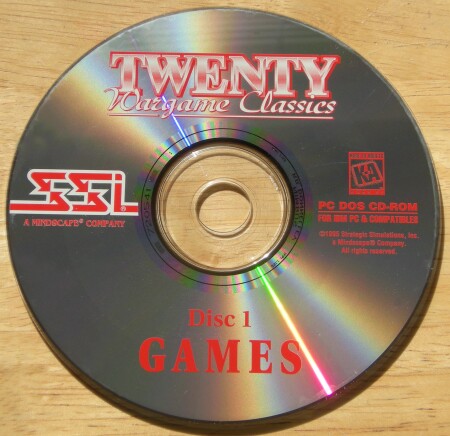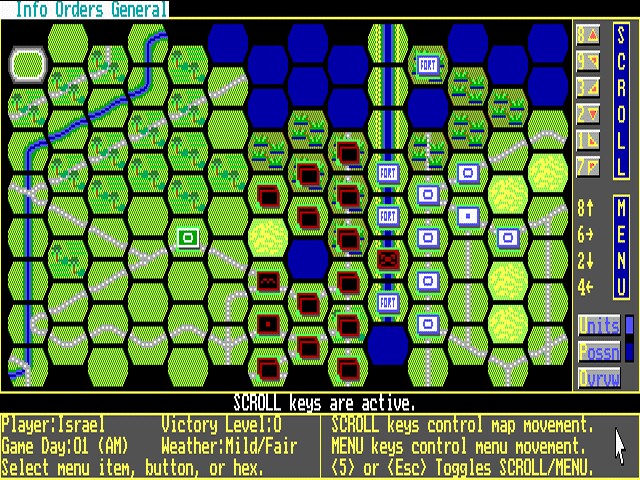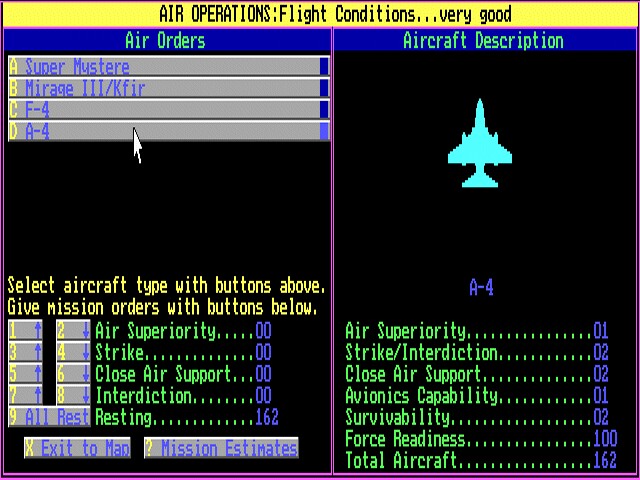
Actual Game
Conflict: Middle East1-Click Install
|
Subtitled "The Arab-Israeli Wars: 1973-?", Conflict: Middle East is SSI's detailed and authoritative simulation of both the Yom Kippur War of 1973, and a hypothetical all-out Arab attack launched sometime "during the Nineties."
The campaigns are fought on a detailed brigade/division/squadron level, across a richly colored hex-grid map of the middle east that stretches from Cairo to Damascus. Victory points are awarded for terrain possession, and some games are interrupted by political intervention from the outside world. You have the option to override this game's interrupts and continue hammering the enemy, but in that case the victory conditions are no longer valid.
Each game turn follows a set sequence: Arab orders, Israeli orders, air operations, ground combat, and finally supply checking and combat resolution. Weather conditions, supply lines, and political developments can all affect the various operations.
There are six levels of difficulty, from pushover to hideous, and these really do do help determine how desperate a situation the Israeli commander faces.
Of the numerous options available, the "air ops" feature is perhaps the most crucial. If you don't want to bother assigning targets for aerial assault, the computer will handle the task - but it tends to be very conservative, allowing squadrons to rest and regain efficiency according to a by-the-book schedule. The Israeli Air Force (at least in the 1973 war) flew until its men dropped in their tracks, pounding Arab SAM sites and air bases around the clock. It's possible to make far more devastating air attacks by pushing your crews to their limit, and even a little bit beyond - after that, however, losses increase dramatically in proportion to results obtained.
There's long been a need for a good Arab-Israeli war simulation and Conflict does not disappoint. The interface is clean and effective, the air-strike results are shown on-screen instead of simply being factored somewhere into the data base, and the campaigns are gripping and entertaining.
The purist approach to battle results is strictly maintained, reporting "the percentage of equipment which must check against survivability" rather than simply telling you how many tanks and guns were knocked out. If you cross-check against the stats listed on the strategic screen, however, you can at least get a rough idea of how much you hurt the enemy during the last turn.
In the early 1990s there were not many being published for the PC format. This one aims, without apologies, for the experienced war gamer, not the beginner - a fact which is reflected in the jargon-heavy documentation. The outlines of play are clear enough, however, and the domesticated interface makes it fairly easy to figure out how to get things moving - as your expertise increases, you can always go back and study the fine points.
Conflict: Middle East is a strong, absorbing, good-looking simulation that fills a conspicuous gap in the catalogue of PC war games, and stands highly recommended.
As is typical of SSI wargames, the cultural context, and historical accuracy of the region in question was a factor in the design of the game. Brilliant game designer Norm Koger:
It is not possible to design a game covering an historical event which accurately reflects all aspects of the event. Readers of history will know more than the original participants. Israeli players of this game will most likely not repeat the bloody, fruitless attacks on Egyptian forces crossing the Suez canal the first day of the war. (If they do, they'll probably only do it once.) Arab commanders will have knowledge which will allow them to exploit their initial successes in ways the original commanders would have considered foolhardy. At lower levels of play the Arab computer player will limit itself to historical strategic decisions, but human players will not be so limited. Some wargame designers try to get around this kind of thing by placing onerous command and control restrictions on players. I have always disliked this approach. When I play a wargame I want to be placed in the position of the original commander without being forced to actually be the original commander.
It is possible to design a game which more or less accurately reflects the physical and political realities of an historical event. The orders of battle and performance characteristics of personnel and equipment are generally well known. In this case, considerable documentation on the situation is available. There is some disagreement on specific details, but the general outline is solid. Wherever possible, I have tried to adhere to the original unit designations for the 1973 scenario. The Israeli forces are actually unassigned battalion or two battalion task forces hastily mobilized and sent to the front. In many cases they are the round out formations for understrength active formations which begin the game elsewhere on the map. The unit designations for the 1990's scenario are completely imaginary; however, thanks to references such as the IISS Military Balance annuals, the orders of battle are reasonably complete and correct.
The only cases of truly questionable organization are in the Egyptian army, which is in the process of reorganization. I have assumed that currently scheduled orders for equipment will be shipped on time, and that some of the Soviet equipment supplied to the Egyptians will be retired by the time of the 1990's scenario.
The word which best describes my opinion on the Arab-Israeli situation is ambivalence. Nobody in that part of the world wears a white hat. Game design considerations were influenced only by past military performance and estimates of current equipment capabilities.
In past conflicts the Israelis have managed to perform very well compared to the Arab forces they have faced. There is no reason to assume that this situa- tion has changed, so there are significant strength modifiers for Israeli forces in both scenarios. I have yet to see an explanation for this that doesn't strike me as uncomfortably trite and smug. If the Arabs ever work through their problem (whatever it is), the Israelis may find themselves in real trouble.
SSI consistently balances historical accuracy, detailed game mechanics, and formidable AI for the computer platform. The result is usually a title with strong replayability. SSI has made the mark once again with Conflict: Middle East.






